Nope, busy with jobs... no time to tinker, to many people with heat out...Any results yet?
You are using an out of date browser. It may not display this or other websites correctly.
You should upgrade or use an alternative browser.
You should upgrade or use an alternative browser.
Cheap 4kwh LiFePO4 batteries from Battery Hookup
- Thread starter Will Prowse
- Start date
it that time of year to make $$$$Nope, busy with jobs... no time to tinker, to many people with heat out...
After a couple of weeks of reading, thinking, and collecting parts, I am finally ready to begin the bottom balancing and capacity testing process on my test battery. For the battery terminal fix, I basically used Supervstech's idea to use the negative of a set of marine terminals made of lead and KBWaldron's idea of making a bushing from 1/2" copper pipe. I also used NOALOX anti-oxidant joint compound conducting grease on each layer of the connector prior to tightening. The resultant terminals are extremely solid and tight with no way to manually twist them around the battery terminal post.
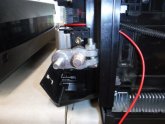
I already have the harness in place for voltage sensing using the existing traces of the BYD battery to the voltages of the cells. My test battery is the one with the #8 cell attachment trace blown so I substituted a wire to complete the 8s 9 pin balance harness and have tested it on the BattGo meter. Total battery voltage is 25.9 v; cell voltages (1-8) are: 3.258; 3.257; 3.243; 3.239; 3.209; 3.245; 3.242; 3.232. Next will install the wires that will be used for cell balancing. I will initially use temporary #6 machine screws in the existing holes of the aluminum bus bars to fasten the ring connectors of this test battery. In the end, I will go with pop rivets. I have a lot of 12 AWG wire from a previous project and plan to use that for the balance wires at least for the initial bottom balancing and capacity testing of each battery. The discussion of using all the same length balance wires was very timely for me. I know the wire size is very large for this purpose but my assumption is it cannot hurt to go larger. Am I correct in this assumption?
Now I need some guidance from forum members. I have read many other posts on this forum where procedures were described with insufficient detail for a newbie like myself to understand or follow. That leads me to think that perhaps more detail may be desirable? However, too much detail gets long and boring to read for those that already know all about it. What guidance can you give me?

I already have the harness in place for voltage sensing using the existing traces of the BYD battery to the voltages of the cells. My test battery is the one with the #8 cell attachment trace blown so I substituted a wire to complete the 8s 9 pin balance harness and have tested it on the BattGo meter. Total battery voltage is 25.9 v; cell voltages (1-8) are: 3.258; 3.257; 3.243; 3.239; 3.209; 3.245; 3.242; 3.232. Next will install the wires that will be used for cell balancing. I will initially use temporary #6 machine screws in the existing holes of the aluminum bus bars to fasten the ring connectors of this test battery. In the end, I will go with pop rivets. I have a lot of 12 AWG wire from a previous project and plan to use that for the balance wires at least for the initial bottom balancing and capacity testing of each battery. The discussion of using all the same length balance wires was very timely for me. I know the wire size is very large for this purpose but my assumption is it cannot hurt to go larger. Am I correct in this assumption?
Now I need some guidance from forum members. I have read many other posts on this forum where procedures were described with insufficient detail for a newbie like myself to understand or follow. That leads me to think that perhaps more detail may be desirable? However, too much detail gets long and boring to read for those that already know all about it. What guidance can you give me?
FilterGuy
Solar Engineering Consultant - EG4 and Consumers
The discussion of using all the same length balance wires was very timely for me. I know the wire size is very large for this purpose but my assumption is it cannot hurt to go larger. Am I correct in this assumption?
Other than the hassle of running large wires, I can not imagine why big balance wires would be a problem. 12 AWG can be a PTA to run in a cramped space. I will be using something smaller for that reason alone.
However, I don't understand why they all have to be the same length either so who knows what magic is happening. (I am starting to wonder if 'the same length' was a requirement for some specific design and that morphed into a general, unquestionable rule for setting up a BMS. )
Keith C
Ahhh, the sharks have him.
When designing electronic control systems you can sometimes use the resistance of the lead wires as part of required circuit resistance. I'm not saying they have here but that CAN be the reason in some circumstances. It could be a particular BMS design did that and so now the community thinks they all need the same length. (Just saying.)
Buzzard Bait
New Member
- Joined
- Dec 15, 2019
- Messages
- 35
Thank you for your input. I have been thinking that there just isn't enough extra wire to worry about, so why not make all the leads the same length just in case it would have an effect.I have wondered about this myself.
Voltage drop across the wires will be zero if there is no current and increase linearly with rising current. If the cells are balanced, the current will be near zero and the voltage drop across the wire will be near zero regardless of the length of the wire. The voltage drop will be the most when the BMS is trying to balance cells. By definition, ballencing is not going to run the same current to/from every cell so if there is any significant voltage drop, the drop will be different for each cell while balancing. I was convinced keeping the lengths the same would not matter, but then I noticed that on some of the bluetooth BMSs there are two wires to one of the cells. Could one be a voltage sence to that cell? If so the BMS could be measuring the resistance of the wire to that cell and then assuming the resistance is the same on all cells. This would give it the data needed to make a good approximation of the voltage at the cell even though there is a voltage drop.
Buzzard Bait
New Member
- Joined
- Dec 15, 2019
- Messages
- 35
I have a water level switch 80' down and used the resistance for the 160' round trip to bring the voltage to a level that the switch could handle, but that was in addition to a resistor at the surface, still it was 24 AGW and 160'. The BMS leads are in inches not feet, but still why risk possible problems over a few inches of wire. As for me I will just make the leads the same length.When designing electronic control systems you can sometimes use the resistance of the lead wires as part of required circuit resistance. I'm not saying they have here but that CAN be the reason in some circumstances. It could be a particular BMS design did that and so now the community thinks they all need the same length. (Just saying.)
I finally got an email with a tracking number. They waited until the batteries were almost here to let me know. I haven't experienced anything like this in my life. I can only guess they are jamming out battery units and aren't much into the office management side of things. Not a very good business model.
I hope the batteries are worth the money. It seems like a good deal.
I hope the batteries are worth the money. It seems like a good deal.
Keith C
Ahhh, the sharks have him.
Ron, what battery company are you referring too?
I just received 16 150AHr cells from "BLS Battery Industries Limited" aka Batterywarehouse.
I bought directly from them not AliAnything.
Ordered Nov 16th . I got nothing but a FedEx number out them that for three weeks came back, "We'll give you a delivery date when the package enters our system". I don't know what shipping scheme they use.
Three boxes showed up on the Dec 18th. The packages had DHL all over them and were delivered by FedEx. The return addy was some guy in the LA area.
The boxes have 4 individually packed cells in each.
The next day the 3-out-of-4 box appeared. Oddly a buddy across town ordered the same exact thing from them the same day. He also got 3 boxes and the next day the fourth.
I will say they were packed more carefully than anything I have ever received in my life. There were literally 20 cut pieces of interlocking closed cell foam surrounding them. They are in sealed cardboard clam-shell boxes with more foam inside Mylar anti-static ziplock bags. The cells look like they were made last week. They have manufactured labels dated October. I have no doubts they are new. Each cell is shockingly heavy/dense.
I just received 16 150AHr cells from "BLS Battery Industries Limited" aka Batterywarehouse.
I bought directly from them not AliAnything.
Ordered Nov 16th . I got nothing but a FedEx number out them that for three weeks came back, "We'll give you a delivery date when the package enters our system". I don't know what shipping scheme they use.
Three boxes showed up on the Dec 18th. The packages had DHL all over them and were delivered by FedEx. The return addy was some guy in the LA area.
The boxes have 4 individually packed cells in each.
The next day the 3-out-of-4 box appeared. Oddly a buddy across town ordered the same exact thing from them the same day. He also got 3 boxes and the next day the fourth.
I will say they were packed more carefully than anything I have ever received in my life. There were literally 20 cut pieces of interlocking closed cell foam surrounding them. They are in sealed cardboard clam-shell boxes with more foam inside Mylar anti-static ziplock bags. The cells look like they were made last week. They have manufactured labels dated October. I have no doubts they are new. Each cell is shockingly heavy/dense.
Keith C
Ahhh, the sharks have him.
Ah, yes, very different. Sorry about that.
Keith C
Ahhh, the sharks have him.
Does that seem competently stable?
How many do you have in your stack?
Are those wheels bolted through the battery cover or a separate plate?
How many do you have in your stack?
Are those wheels bolted through the battery cover or a separate plate?
Tapped and Bolted to the heat sink, very stable, just 2 stacked, this way I can pull out if I need to access it. not towing anywhere, all 4 swivel
Bit of a pain to roll around. May switch to 2
Non swivel wheels. And 2 rubber blocks with a handle,
Had to get off kitchen table Xmas dinner tomorrow. ?
Also stackable will use the four holes in heat sink to tap and bolt.
Bit of a pain to roll around. May switch to 2
Non swivel wheels. And 2 rubber blocks with a handle,
Had to get off kitchen table Xmas dinner tomorrow. ?
Also stackable will use the four holes in heat sink to tap and bolt.
Keith C
Ahhh, the sharks have him.
Excellent!
Thanks for those details.
I have 6 coming and was wondering what I was going to do. I think I know now!
Thanks for those details.
I have 6 coming and was wondering what I was going to do. I think I know now!
jasonhc73
Cat herder, and dog toy tosser.
"ITS IMPORTANT TO HAVE BALANCING IF YOU PLAN ON FULLY CHARGING AND FULLY DISCHARGING. JUST SEARCH ALIEXPRESS FOR "8S ACTIVE BALANCER". OR YOU CAN USE AN 8S BALANCE CHARGER WITH THE BALANCING FEATURE.
NOMINAL VOLTAGE IS 25.6V
FULLY CHARGED IS 29.2V
FULLY DISCHARGED IS 20V"
Charging to 56 (instead of 100% 58.4)
Returning to the utility at 44 (instead of 40) - No BMS!
(I have grid-tied solar. These inverters (LV5048sj) support 8 kW each, 4x2 solar inputs)
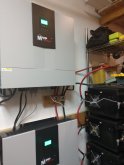
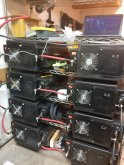
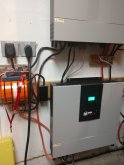
1st test!
S - U - C - C - E -S - S
Whole house on battery! YES!!!!!! 1st test.
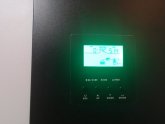
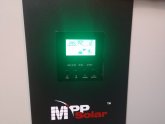
I can't figure out the software monitor yet though, I guess it only works WiFi, but I'm connected USB and nothing.
NOMINAL VOLTAGE IS 25.6V
FULLY CHARGED IS 29.2V
FULLY DISCHARGED IS 20V"
Charging to 56 (instead of 100% 58.4)
Returning to the utility at 44 (instead of 40) - No BMS!
(I have grid-tied solar. These inverters (LV5048sj) support 8 kW each, 4x2 solar inputs)



1st test!
S - U - C - C - E -S - S
Whole house on battery! YES!!!!!! 1st test.


I can't figure out the software monitor yet though, I guess it only works WiFi, but I'm connected USB and nothing.
Keith C
Ahhh, the sharks have him.
Sweet Jason! I'm considering switching my new LV2424 out for a 48V version.
Output is 5kW each correct?
And you're using them ganged together with split phase outputs? (120V-N-120V)
Output is 5kW each correct?
And you're using them ganged together with split phase outputs? (120V-N-120V)
is that the normal specs for the byd, 3.65?V I have read on this 3.65 is extreme only on new battery 2.5v is the extreme low,, no bms? wtf. you waste no time, wow"ITS IMPORTANT TO HAVE BALANCING IF YOU PLAN ON FULLY CHARGING AND FULLY DISCHARGING. JUST SEARCH ALIEXPRESS FOR "8S ACTIVE BALANCER". OR YOU CAN USE AN 8S BALANCE CHARGER WITH THE BALANCING FEATURE.
NOMINAL VOLTAGE IS 25.6V
FULLY CHARGED IS 29.2V
FULLY DISCHARGED IS 20V"
Charging to 56 (instead of 100% 58.4)
Returning to the utility at 44 (instead of 40) - No BMS!
(I have grid-tied solar. These inverters (LV5048sj) support 8 kW each, 4x2 solar inputs)
View attachment 3933View attachment 3934View attachment 3935
1st test!
S - U - C - C - E -S - S
Whole house on battery! YES!!!!!! 1st test.
View attachment 3936View attachment 3937
I can't figure out the software monitor yet though, I guess it only works WiFi, but I'm connected USB and nothing.
They weight a ton, I am keeping very close to the ground, on a rack too risky for me,, may jam my toe on it, smiles I will send an update on the changes.Excellent!
Thanks for those details.
I have 6 coming and was wondering what I was going to do. I think I know now!
I do like Jason system, I prefer being slow and cautious,
jasonhc73
Cat herder, and dog toy tosser.
is that the normal specs for the byd, 3.65?V I have read on this 3.65 is extreme only on new battery 2.5v is the extreme low,, no bms? wtf. you waste no time, wow
Each pack was 23.3 to 23.5 when I started.
So just go to ~95% max and 10 % min. I am also only charging at 20 amps for now. That's only ~0.3 amp per cell.
I know it's less efficient, but I don't plan on using it for days on end. Just 5 hours 5 days a week.
Similar threads
- Replies
- 12
- Views
- 557
- Replies
- 0
- Views
- 146
- Replies
- 10
- Views
- 609
- Replies
- 17
- Views
- 869




